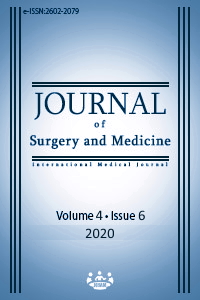Assessment of diagnosis and treatment of geriatric patients in otorhinolaryngology
Keywords:
Geriatrics, Otorhinolaryngology, EpidemiologyAbstract
Aim: Otorhinolaryngological problems worsen the social interaction of the elderly and cause addiction and depression in patients. There are a limited number of studies in the literature that examine the otorhinolaryngological disorders of the geriatric population. Through analysis of ENT patients' demographic features, diagnostic distributions, and service processes in ENT inpatient ward, this study aims to obtain data that can guide the efforts in improving future service offered for these patients.
Methods: In this cross-sectional study, the records of patients aged 65 years and over who were consulted from outpatient or emergency clinics and other departments, such as the intensive care unit to the ENT Department of KSBU Evliya Çelebi Training and Research Hospital between 01.01.2017 and 31.12.2019 (including 31.12.2019) were scanned retrospectively. Diagnoses, laboratory, radiological and audio-vestibular evaluations, and treatment processes of the patients included were analyzed.
Results: Among 12509 patients included in the study, 5792 were female (46.3%) and 6717 (53.7%) were male. The most frequent consultation to the ENT outpatient clinic was due to otological complaints with 8594 (68.7%) patients. The main tests used in the evaluation of patients were 5272 audiometric tests, 1585 laboratory tests (hemogram - biochemistry), and 508 computed tomography. The most common diagnoses were hearing loss (24.89%), followed by cerumen impaction (22.07%). Various surgical interventions were performed on 332 (2.65%) patients included in the study. Most common surgical operations were head/neck surgery (134 surgeries), and the most common surgical intervention was tracheotomy (46 patients).
Conclusion: Majority of geriatric patients are outpatients and frequently present with autological complaints. Surgical operation was performed to geriatric patients mostly due to oncological disorders.
Downloads
References
Karakaş N, Bentli R, Fırıncı B, Zabcı B. Investigation of the relationship between depression and nutritional status of elderly patients in home care. J Surg Med. 2019;3(12):829-32.
Turkish Statistical Institute. Accessed on: http://www.tuik.gov.tr/UstMenu.do?metod=temelist. [Access date: 05.04.2020]
Loğoğlu A, Ayrık C, Köse A, Bozkurt S, Demir F, Narcı H. Analysis of non-traumatic elderly patient presentations to the emergency department Tr J Emerg Med. 2013;13(4):171-9
Strange GR, Chen EH, Sanders AB. Use of emergency departments by elderly patients: projections from a multicenter data base. Ann Emerg Med. 1992;21:819-24.
Unsal A, Cevik AA, Metintaş S, Arslantaş D, İnan OC. Emergency department visits by elder patients. Turkish Journal of Geriatrics. 2003;6:83-8.
Gülalp B, Aldinç H, Karagün Ö, Çetinel Y, Benli S. The complaint and outcome of geriatric patient in emergency department. Tr J Emerg Med. 2009;9:73-7.
jamovi - Stats. Open. Now. [Last accessed on 21/06/2020]. Available from: https://www.jamovi.org .
Wofford JL, Schwartz E, Timerding BL, Folmar S, Ellis SD, Messick CH. Emergency department utilization by the elderly: analysis of the National Hospital Ambulatory Medical Care Survey. Acad Emerg Med. 1996;3:694-9.
Vanpee D, Swine C, Vandenbossche P, Gillet JB. Epidemiological profile of geriatric patients admitted to the emergency department of a university hospital localized in a rural area. Eur J Emerg Med. 2001;8:301-4.
Bray F, Ferlay J, Soerjomataram I, Siegel RL, Torre LA, Jemal A. Global cancer statistics 2018: Glocoban estimates of incidence and mortality worldwide for 36 cancers in 185 countries. CA: A Cancer Journal for Clinicians. 2018;68:394-424. doi:10.3322/caac.21492
General Directorate of Public Health Turkey's Cancer Statistics 2014. https://hsgm.saglik.gov.tr/depo/units/cancer-dB/statistics/2014-rapor._uzuuun.pdf
Ezber A, Köroğlu M, Yıldız G, Ardıç FN. The distribution of head and neck tumors in Denizli region and its effects on usage of clinic resources. Pamukkale Medical Journal. 2020;13(1):53-9.
Giri PA, Phalke DB, Kishve SP, Mangla D, Syed MMA. Otorhinolaryngological disorders in a geriatric population: A study from a rural tertiary care hospital in India. AMJ. 2010;3(5):291-4. doi: 10.4066 / AMJ.2010.277
World Health Organization (WHO), Aging: Exploding the Myths, 1999 [Access date: 11/05/2020] Avalible from: http://apps. who.int/iris/bitstream/10665/66330/1/WHO_HSC_AHE_99.1.pdf, p.4-6.
Creighton FX, Poliashenko SM, Statham MM, Abramson P, Johns MM. The growing geriatric otolaryngology patient population: A study of 131,700 new patient encounters. The Laryngoscope. 2013;123:97-102. doi:10.1002/lary.23476
Okoye BC, Onotai LO. Pattern of geriatric otolaryngological diseases in Port Harcourt. Niger I Med. 2007;16(3):239-41.
Cruickshanks KJ, Wiley TL, Tweed TS, K Lein BE, Klein R, Mares - Perlman JA, et al. Prevalence of Hearing Loss in Older Adults in beaver Dam, Wisconsin. The epidemiology of Hearing Loss Study. Am J Epidemiol. 1998;148(9):879-86.
Timsit CA, Bouchene K, Olfatpour B, Herman P, Tran Ba Huy P. Epidemiology and clinical findings in 20,563 patients attending the Lariboisiere Hospital ENT Adult Emergency Clinic. Ann Otolaryngol Chir Cervicofac. 2001;118(4):215-24.
Özler GS, Yengil E. Why do geriatric patients visit otorhinolaryngology? ENT-Ear, Nose & Throat Journal. 2016;95(6):224-9.
Jahn, K. The Aging Vestibular System: Dizziness and Imbalance in the Elderly. Vestibular Disorders. 2019;82:143–9. doi: 10.1159 / 000 490 283
Al-Qurayshi Z, Sullivan BS, Schwalje A, Walsh J, Bayon R, Tufano R, Kandil E. Presentation and outcomes of elderly patients undergoing head and neck surgeries: a national perspective. Otolaryngology – Head and Neck Surgery. 2020;1-9. https://doi.org/10.1177/0194599820911727
Topuz MF. Trakeotomi. In: Müderris T, Muz SE, Kesici GG, İslamoğlu Y, eds. Kulak burun boğaz hastalıklarında temel yaklaşım ve yönetim. Ankara: Akademisyen yayınevi; 2020. Pp.41-51.
Downloads
- 579 887
Published
Issue
Section
How to Cite
License
Copyright (c) 2020 Muhammet Fatih Topuz
This work is licensed under a Creative Commons Attribution-NonCommercial-NoDerivatives 4.0 International License.
















